Back on Site
I’ve been back on site for a week now and am happy to rejoin the team for my second season. It’s great to see Richard, Mary, Bill, Elsie, Jaap and Ben again, and there are many familiar faces among our Egyptian colleagues this year including the conservator Khaled Mohamed Wassel, and the head mason Mohamed Gharib and his crew. I also had the pleasure of meeting for the first time our SCA inspector Osama Saadalla Hamdoun and Herman te Velde, a specialist in Ptolemaic religious texts.
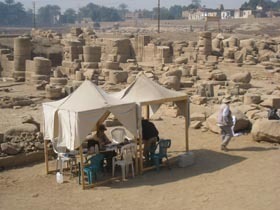
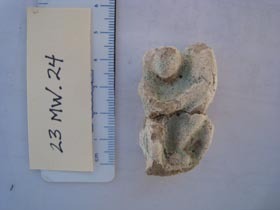
My first few days here were spent recovering from the two day journey and seven hour time change, as well as organizing the conservation supplies and hunting down a few things in the souq (the market) that I didn’t bring with me. I also walked around the site to view a month’s worth of excavations, and then staked my claim to one of the tables under the tent shown in the photo on the left where I began to treat small finds (coins, ceramic sherds, and faience objects). Shown in the photo on the right is a small faience object broken into three pieces that I repaired with Paraloid B-72, an acrylic resin widely used in conservation because of it’s stability and reversibility. The object is actually a crouching male figure holding a rather large appendage between his legs that extends over his shoulder. Yes, the ancient Egyptians did have a sense of humor!
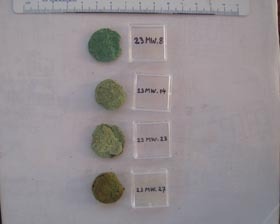
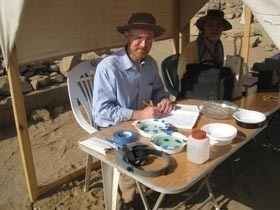
The photo on the left shows what excavated coins often look like. They are round lumps of blue or green mineralized copper corrosion products and encrusted soil that may or may not have copper alloy (metal) left in their cores. They have to be carefully cleaned because frequently the only details remaining from the original surface of a badly corroded coin are in the corrosion layer itself. Cleaning can be done mechanically with wooden tools and soft brushes or in a very controlled way with chemicals. In the photo on the right I’m making treatment notes while soaking some of the coins in a 10% solution of EDTA (ethylene diamine tetra acetic acid) in water made basic with a little ammonia. This solution softens the encrusted dirt and mineralized corrosion products allowing them to be carefully removed. Stay tuned to see if I find any legible detail on this year’s coins, which might help the archaeologists date the place where they were found.
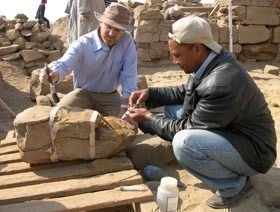
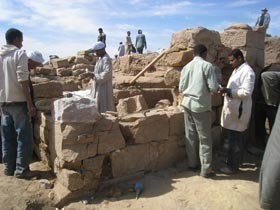
Mary has already written describing the stabilization of the north wing of the Taharqa gate. Khaled has been doing an amazing job with Mohamed and his team on this huge project. As I arrived, work began on the south wing, which is in worse condition than the north. Many of the sandstone blocks are badly deteriorated and require hours of consolidation with dilute solutions of B-72 acrylic resin applied with a syringe or brush. Some blocks are beyond help and have lost all cohesion and reverted to sand. These will be replaced with new sandstone blocks necessary for the structural stability of the wing. In the picture on the left I’m helping Khaled apply B-72 consolidant to a stone fragment from the south wing, and on the right is an overall picture of the wing where you can get an idea of what bad shape it’s in.
As I said before, I’m glad to be back and looking forward to the challenges of another season of conservation on site. I was reminded that I’m working outdoors again by the strong winds and blowing dust during my first couple of days. I made sure the artifacts were safe, held on to my hat, and kept my mouth shut…good advice for any number of situations, LOL!

John is a conservator of sculpture and decorative arts at the Detroit Institute of Arts where his responsibilities include all aspects of the examination, preservation, and treatment of sculpture and decorative arts in the permanent collection, including Ancient, European, Asian, African, Oceanic, American, and Contemporary art. He received his M.A. in conservation from the State University College at Buffalo in 1990. His field experience has included the treatment of the limestone sculpture on the west front of Wells Cathedral in England, treatment of the sandstone frieze on Boston’s Trinity Church, and the restoration of ceramics excavated at the site of the former Chinese Imperial kilns in Jingdezhen, China.
